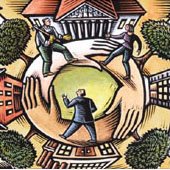 The Internet is disintermediating whole businesses. Independent action by companies is not possible and the Internet is in 'Hurry up' mode. The effects impact business, social and economic on a grand scale.
The Internet is disintermediating whole businesses. Independent action by companies is not possible and the Internet is in 'Hurry up' mode. The effects impact business, social and economic on a grand scale.The UK company WH Smith announced plans to split into two separate quoted companies, focusing on its retail operations and news distribution.
The WH Smith retail business, founded more than 200 years ago and which now operates 674 stores in high streets, train stations and airports, is to be demerged from the news distribution operation, which delivers magazines and newspapers to retailers on behalf of publishers.
By far the biggest distributor of news is now the Internet and large part of that is delivered via search engines like Google and Yahoo. That is not to say that consumer magazines and local newspapers will not flourish and require WHS style distribution. In addition WHS has the infrastructure to add new lines and contracts to lever some returns from its high speed delivery capability.
The Internet has put Marketing on the back foot and gone further: the business model has been disintermediated!
The demerger plan was announced as the group posted half-year profits up 4% at £71m. The increase was achieved despite slowing sales in both parts of the business and as a result of CEO, Ms Kate Swann's strategy of increasing margins and cutting costs. Ms Swann said margins could be improved further, but conceded that eventually she would have to find a way to boost top-line sales.
With, online sales in the UK penetrating deeper into the retail markets than in the USA and with the Internet now bigger than Oxford Street, WHS could do worse that ship online purchases round the country for dot.coms using local franchises to do the 'last mile'. It would be ironic if such a service began to deliver books for Amazon.
In the meantime, there is a great case for implementing a proper relationship management plan and that includes a stakeholder modelling programme up front.
Having said all of that, there is fly in the ointment. The 'real' real world hoarding gold against hard times is back. This time I do not think it will hurt the dot.com businesses. It may even give them a spur but it will tough on the old giants and the people who employ them, as unemployment continues to rise.Will the sale of the London Stock Exchange on Wednesday be at the market peak?
Picture: The London Stock Exchange Daily Telegraph























